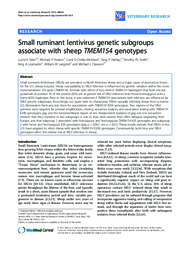Small ruminant lentivirus genetic subgroups associate with sheep TMEM154 genotypes.
Small ruminant lentivirus genetic subgroups associate with sheep TMEM154 genotypes.
Autoria: SIDER, L. H.; HEATON, M. P.; CHITKO-McKOWN, C. G.; HARHAY, G. P.; SMITH, T. P. L.; LEYMASTER, K. A.; LAEGREID, W. W.; CLAWSON, M. L.
Resumo: Abstract: Small ruminant lentiviruses (SRLVs) are prevalent in North American sheep and a major cause of production losses for the U.S. sheep industry. Sheep susceptibility to SRLV infection is influenced by genetic variation within the ovine transmembrane 154 gene (TMEM154). Animals with either of two distinct TMEM154 haplotypes that both encode glutamate at position 35 of the protein (E35) are at greater risk of SRLV infection than those homozygous with a lysine (K35) haplotype. Prior to this study, it was unknown if TMEM154 associations with infection are influenced by SRLV genetic subgroups. Accordingly, our goals were to characterize SRLVs naturally infecting sheep from a diverse U.S. Midwestern flock and test them for associations with TMEM154 E35K genotypes. Two regions of the SRLV genome were targeted for proviral amplification, cloning, sequence analysis, and association testing with TMEM154 E35K genotypes: gag and the transmembrane region of env. Independent analyses of gag and env sequences showed that they clustered in two subgroups (1 and 2), they were distinct from SRLV subtypes originating from Europe, and that subgroup 1 associated with hemizygous and homozygous TMEM154 K35 genotypes and subgroup 2 with hemi- and homozygous E35 genotypes (gag p < 0.001, env p = 0.01). These results indicate that SRLVs in the U.S. have adapted to infect sheep with specific TMEM154 E35K genotypes. Consequently, both host and SRLV genotypes affect the relative risk of SRLV infection in sheep.
Ano de publicação: 2013
Tipo de publicação: Artigo de periódico
Unidade: Embrapa Caprinos e Ovinos
Palavras-chave: Animal genetic, Diseases, Doença animal, Filogenia, Genotipagem, Genotypes, Genotyping, Genética animal, Lentivirus, Ovino, Phylogeny, SRLV, Sheep, Small ruminants, TMEM154, Virologia, Virology, Virus
Observações
1 - Por padrão são exibidas publicações dos últimos 20 anos. Para encontrar publicações mais antigas, configure o filtro ano de publicação, colocando o ano a partir do qual você deseja encontrar publicações. O filtro está na coluna da esquerda na busca acima.
2 - Para ler algumas publicações da Embrapa (apenas as que estão em formato ePub), é necessário ter, no celular ou computador, um desses softwares gratuitos. Sistemas Android: Google Play Livros; IOS: iBooks; Windows e Linux: software Calibre.
Acesse outras publicações
Acesse a Base de Dados da Pesquisa Agropecuária (BDPA) para consultar o acervo completo das bibliotecas da Embrapa.

